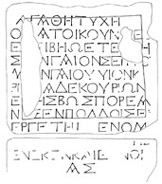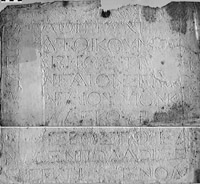 MAMA XI 65 (Sebaste)
MAMA XI 65 (Sebaste) 
Honorific base for C. Septumius C.f. Carbo
- Type of monument:
- Honorific base.
- Location:
- Payamalanı (Sebaste): in the village.
- Description:
- Marble block in two fragments. Fragment A well-preserved, with two deep holes to left and right, and a shallow groove outlining a rectangular panel, perhaps for later re-use as a pier-base; fragment B severely battered.
- Dimensions:
- Ht. 0.43 (fr. A), 0.31 (fr. B); W. 0.50; Th. 0.22; letters 0.030-0.035.
- Record:
- Squeeze; line drawing; WMC notebook copy (1954/25).
- Publication:
- None; mentioned by Ballance 1995: 188-9; Thonemann 2011a: 152.
- Date:
- c. AD 73-113.
ἀγαθῇ τύχῃ A
ο[ἱ κ]ατοικοῦν[τ]ες̣
ἐ[ν] Ε̣ιβηω ἐτε[ίμ]η-
σ[α]ν Γάϊον Σεπ̣τ̣ο[ύ]-
5μ[ιο]ν Γαίου υἱὸν Κ[ά]-
ρβ̣[ων]α δεκουρίων[α]
ε[ἴλ]ης Βωσπορεα-
ν[ῆ]ς ἐν πολλοῖς εὐ̣-
εργέτην̣ [γ]ενόμ[ε]-
10[νον δικαιοσύν]η̣ς̣ B
ἕνεκεν καὶ ε[ὐ]νοί-
ας.
With good fortune. Those living in Eibeos/on honoured C. Septumius C.f. Carbo, decurion of the ala Bosporeana, having acted as their benefactor in many respects, for the sake of his justice and goodwill.






The village of Eibeos/on, situated on a hill overlooking the hamlet of Payamalanı, is also named in two unpublished inscriptions. In the first, copied by N. Fıratlı in 1973 (Stillwell 1976: 293-4, s.v. Eibeos), the village’s name also appears in the dative, Ειβηω. The second inscription, now on display in the Uşak museum, records the dedication by the ‘village of the Eibeanoi’ ([ἡ] Ειβεανῶν κατοικ⟨ί⟩α) of a temple and cult-statue to Helios Apollo Lairmenos (see the commentary to MAMA XI 70 [1955/125]). For the site at Payamalanı (which dates back to the Hellenistic period, and continued to be home to a large settlement under the Roman empire), see Ramsay, Phrygia II 584-5, 597-8, 606; Buresch 1898: 171-2; Fıratlı 1970: 118-9; Waelkens 1986: 182.
The ala I Bosporanorum is firmly attested in Syria in AD 54 (PME L 16: M. Licinius Rufus), where it seems to have remained until the end of the Judaean war in AD 73 (PIR2 R 261, praef. T. Rutilius Varus). The unit was stationed in Pannonia by 113 at the latest (RMD II 86). This inscription provides our only evidence that the unit was stationed in Asia for a period; their base was probably the garrison-town of Eumeneia, home to the cohors I Claudia Sugambrorum ueterana equitata from the reign of Hadrian (Buckler, Calder and Cox 1926: 74-8, no. 201; I.Denizli 35; Thonemann, 2011a: 152-3). The date at which the ala I Bosporanorum arrived in Asia is unknown; for arguments in favour of AD 75, see Thonemann, 2011a: 152.